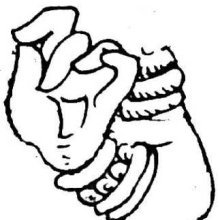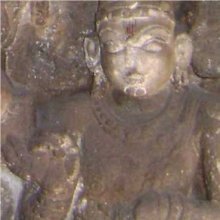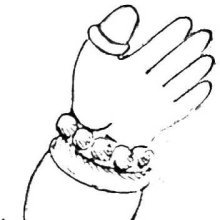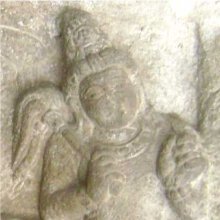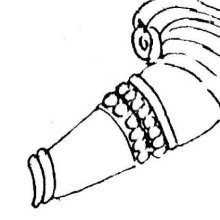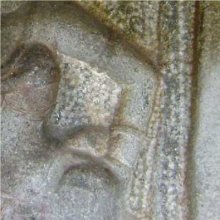Valaya, Valāya: 31 definitions
Introduction:
Valaya means something in Buddhism, Pali, Hinduism, Sanskrit, Jainism, Prakrit, the history of ancient India, Marathi, Hindi. If you want to know the exact meaning, history, etymology or English translation of this term then check out the descriptions on this page. Add your comment or reference to a book if you want to contribute to this summary article.
Alternative spellings of this word include Valay.
Images (photo gallery)
(+19 more images available)
In Hinduism
Purana and Itihasa (epic history)
Source: Google Books: Cultural History from the Vāyu PurānaValaya (वलय)—One of the Heavenly ornaments according to the Vāyu Purāṇa. Its use is associated with the people of the Kuru land.
Source: archive.org: Shiva Purana - English TranslationValaya (वलय) refers to “bangles” (i.e., ornamental decoration), according to the Śivapurāṇa 2.2.21. Accordingly as Brahmā narrated to Nārada:—“[...] When they [viz., Śiva’s Gaṇas (attendants)] went away and He was left alone with Satī, Śiva rejoiced much and sported with her. [...] Sometimes he would take the necklace off her breasts and press them with his hands. Sometimes he would remove the bracelets, bangles (valaya), rings from their places and fix them again one by one”.

The Purana (पुराण, purāṇas) refers to Sanskrit literature preserving ancient India’s vast cultural history, including historical legends, religious ceremonies, various arts and sciences. The eighteen mahapuranas total over 400,000 shlokas (metrical couplets) and date to at least several centuries BCE.
Vastushastra (architecture)
Source: Wisdom Library: Vāstu-śāstraValaya (वलय) refers to a type of temple (prāsāda) classified under the group named Kailāśa, according to Samarāṅgaṇasūtradhāra chapter 49. The Kailāśa group contains ten out of a sixty-four total prāsādas (temples) classified under five prime vimānas (aerial car/palace), which were created by Brahmā for as many gods (including himself). This group represents temples (e.g. Valaya) that are to be globular shaped. The prāsādas, or ‘temples’, represent the dwelling place of God and are to be built in towns. The Samarāṅgaṇasūtradhāra is an 11th-century encyclopedia dealing with various topics from the Vāstuśāstra.
Valaya is also listed in the Agnipurāṇa which features a list of 45 temple types. It is listed under the group named Kailāśa, featuring circular-shaped temples. This list represents a classification of temples in Nort-India.

Vastushastra (वास्तुशास्त्र, vāstuśāstra) refers to the ancient Indian science (shastra) of architecture (vastu), dealing with topics such architecture, sculpture, town-building, fort building and various other constructions. Vastu also deals with the philosophy of the architectural relation with the cosmic universe.
Natyashastra (theatrics and dramaturgy)
Source: Wisdom Library: Nāṭya-śāstraValaya (वलय) refers to a kind of ornament (ābharaṇa) for the fore-arm (bāhu) to be worn by males, according to Nāṭyaśāstra chapter 23. Such ornaments for males should be used in cases of gods and kings.
Valaya (वलय) also refers to “bangles”, an ornament (ābharaṇa) for the upper-arm (bāhumūla, ‘arm-pit’) to be worn by females. Such ornaments for females should be used in cases of human females and celestial beings (gods and goddesses).
Ābharaṇa (‘ornaments’, eg., valaya ) is a category of alaṃkāra, or “decorations”, which in turn is a category of nepathya, or “costumes and make-up”, the perfection of which forms the main concern of the Āhāryābhinaya, or “extraneous representation”, a critical component for a successful dramatic play.

Natyashastra (नाट्यशास्त्र, nāṭyaśāstra) refers to both the ancient Indian tradition (shastra) of performing arts, (natya—theatrics, drama, dance, music), as well as the name of a Sanskrit work dealing with these subjects. It also teaches the rules for composing Dramatic plays (nataka), construction and performance of Theater, and Poetic works (kavya).
Shilpashastra (iconography)
Source: Shodhganga: Vaisnava Agamas And Visnu ImagesValaya (वलय) refers to a “bangle” and represents a type of “hand-ornaments” (hastabhūṣaṇa), as defined in treatises such as the Pāñcarātra, Pādmasaṃhitā and Vaikhānasa-āgamas, extensively dealing with the technical features of temple art, iconography and architecture in Vaishnavism.—There are a number of ornaments for hand and arms. According to Bharata, [viz., aṅgada (armlet) and valaya (bangle) are for upper part of arm].

Shilpashastra (शिल्पशास्त्र, śilpaśāstra) represents the ancient Indian science (shastra) of creative arts (shilpa) such as sculpture, iconography and painting. Closely related to Vastushastra (architecture), they often share the same literature.
Ayurveda (science of life)
Source: gurumukhi.ru: Ayurveda glossary of termsValaya (वलय):—[valayaṃ] Ring like appearance

Āyurveda (आयुर्वेद, ayurveda) is a branch of Indian science dealing with medicine, herbalism, taxology, anatomy, surgery, alchemy and related topics. Traditional practice of Āyurveda in ancient India dates back to at least the first millenium BC. Literature is commonly written in Sanskrit using various poetic metres.
Shaivism (Shaiva philosophy)
Source: Brill: Śaivism and the Tantric Traditions1) Valaya (वलय) refers to “bracelets”, according to the Guhyasūtra chapter 3.—Accordingly, “[...] One may perform the Block-of-Wood Observance in a forest full of bears, tigers and lions, conquering the urges to sleep and eat, [constantly] reciting. If one takes on the appearance of a woman and sings and dances, adorned with bracelets (valaya-bhūṣita), with a winnowing fan, ball and plait, one observes the Colourful Observance. With a weapon in hand, full of compassion, if one wanders like a saviour of creatures (?) focussed upon recitation, meditation and worship, one performs the Warrior Observance. [...]”.
2) Valaya (वलय) refers to a “bangle” (worn as an ornament), according to the Guhyasūtra chapter 9.—Accordingly, “[...] [The Lord spoke]:—[...] On one half, there should be a forehead mark; on one half a [forehead] eye. A ring [should be] in one ear; a [pendant] ear-ornament in one ear. He should put a trident in his right hand and a breast on his left side, a girdle on the left half, a bangle (valaya) on the left arm, a woman’s anklet on the left leg, a man’s anklet on the right leg and a muñja-grass belt. At the hips, he should put a loin-cloth on the right and wear a woman’s garment on the left.”.

Shaiva (शैव, śaiva) or Shaivism (śaivism) represents a tradition of Hinduism worshiping Shiva as the supreme being. Closely related to Shaktism, Shaiva literature includes a range of scriptures, including Tantras, while the root of this tradition may be traced back to the ancient Vedas.
Kavya (poetry)
Source: Brill: Śaivism and the Tantric Traditions (kavya)Valaya (वलय) refers to “bracelets”, according to Bāṇa’s Kādambarī (p. 225).—Accordingly, while describing the shire of the Goddess Caṇḍikā, “[Then the portal to the sanctum sanctorum, a riot of colour and form:] She was being illuminated by the entrance, on which there were hanging cloths reddened by lamp-smoke, a row of bracelets made of peacock-throats (śikhigala-valaya-āvali) festooned [over it], a garland of bells closely-set and pale with powdered flour-cakes, which supported two door-panels, [studded] with tin lion heads with thick, iron pins in their centres, barricaded with an ivory-rod bolt, carrying [what seemed to be] a necklace of sparkling bubbles that were mirrors oozing yellow, blue and red [light]”.

Kavya (काव्य, kavya) refers to Sanskrit poetry, a popular ancient Indian tradition of literature. There have been many Sanskrit poets over the ages, hailing from ancient India and beyond. This topic includes mahakavya, or ‘epic poetry’ and natya, or ‘dramatic poetry’.
In Buddhism
Mahayana (major branch of Buddhism)
Source: De Gruyter: A Buddhist Ritual Manual on AgricultureValaya (वलय) refers to “coiling (figures)”, according to the Vajratuṇḍasamayakalparāja, an ancient Buddhist ritual manual on agriculture from the 5th-century (or earlier), containing various instructions for the Sangha to provide agriculture-related services to laypeople including rain-making, weather control and crop protection.—Accordingly, [As the Bhagavān said]: “Now I shall teach the offering manual which is auspicious and can bring about any effect. [...] Seven coiling figures (rūpaka-valaya) should be made and rice spirals. Twenty-one figures should be prepared one after the other. Boiled rice, milk rice, a dish of rice and peas, yoghurt and thickened milk should be placed. Fruits and flowers should be placed. Four jars should be placed. Preceded by a great offering barley-meal should be placed as foremost. [...]”.

Mahayana (महायान, mahāyāna) is a major branch of Buddhism focusing on the path of a Bodhisattva (spiritual aspirants/ enlightened beings). Extant literature is vast and primarely composed in the Sanskrit language. There are many sūtras of which some of the earliest are the various Prajñāpāramitā sūtras.
Tibetan Buddhism (Vajrayana or tantric Buddhism)
Source: MDPI Books: The Ocean of HeroesValaya (वलय) refers to “encircling” (a particular Cakra), according to the 10th-century Ḍākārṇava-tantra: one of the last Tibetan Tantric scriptures belonging to the Buddhist Saṃvara tradition consisting of 51 chapters.—Accordingly: [while explaining the speech circle (vākcakra)]: “[...] This way, [the circles] starting with the Knowledge and ending with the Body are stated to be a wheel encircling (valaya) the Water, Fire, [Earth,] Wind, and Space [Circles]. [Their] excellent Yoginīs should be discerned. The Speech Circle, the second, in the Emanation Layer is thus [taught]. [...]”

Tibetan Buddhism includes schools such as Nyingma, Kadampa, Kagyu and Gelug. Their primary canon of literature is divided in two broad categories: The Kangyur, which consists of Buddha’s words, and the Tengyur, which includes commentaries from various sources. Esotericism and tantra techniques (vajrayāna) are collected indepently.
In Jainism
General definition (in Jainism)
Source: The University of Sydney: A study of the Twelve ReflectionsValaya (वलय) refers to the “(three great) rings”, according to the 11th century Jñānārṇava, a treatise on Jain Yoga in roughly 2200 Sanskrit verses composed by Śubhacandra.—Accordingly, “The cosmos is the shape of a palm tree, filled with the three worlds [com.—What kind of cosmos is it? It is completely covered (samākīrṇo), covered (vyāptaḥ), by the three (tribhiḥ), by the three (tribhiḥ) great rings (mahāvalayaiḥ)] , surrounded by the three winds having great speed [and] great power in between [the cosmos and non-cosmos]. That [cosmos] is not at all produced by anyone, not at all sustained by anyone, so also not destroyed by anyone. Nevertheless, that exists by itself without support in the atmosphere”.
Source: Singhi Jain Series: Ratnaprabha-suri’s Kuvalayamala-kathaValaya (वलय) refers to “(bejewelled) bracelets”, according to the 8th-century Kuvalayamālā written by Uddyotanasūri, a Prakrit Campū (similar to Kāvya poetry) narrating the love-story between Prince Candrāpīḍa and the Apsaras Kādambarī.—The Campū opens with salutations to the great Tirthaṃkaras on the occasion of whose birth even the gods take part in the great festival, clapping their hands with bejewelled bracelets (maṇi-valaya, 1.2).

Jainism is an Indian religion of Dharma whose doctrine revolves around harmlessness (ahimsa) towards every living being. The two major branches (Digambara and Svetambara) of Jainism stimulate self-control (or, shramana, ‘self-reliance’) and spiritual development through a path of peace for the soul to progess to the ultimate goal.
India history and geography
Source: Cologne Digital Sanskrit Dictionaries: Indian Epigraphical GlossaryValaya.—(CITD), a ring; a bracelet; in Telugu-Kannaḍa, also an enclosure, a boundary. Note: valaya is defined in the “Indian epigraphical glossary” as it can be found on ancient inscriptions commonly written in Sanskrit, Prakrit or Dravidian languages.
Source: Singhi Jain Series: Ratnaprabha-suri’s Kuvalayamala-katha (history)Valaya (वलय) refers to one of the various shops or “market places” (Sanskrit: Haṭṭa, Prakrit: Cauhaṭṭa) for a medieval town in ancient India, which were vividly depicted in Kathās (narrative poems), for example, by Uddyotanasūri in his 8th-century Kuvalayamālā.—The Kuvalayamala (779 A.D.) is full of cultural material which gains in value because of the firm date of its composition. [...] In the Kuvalayamālā, some names of shops according to articles displayed in them is given, [i.e., valaya] [...] Thus Uddyotana has in his view a complete form of a medieval market place with the number of lines full of different commodities.

The history of India traces the identification of countries, villages, towns and other regions of India, as well as mythology, zoology, royal dynasties, rulers, tribes, local festivities and traditions and regional languages. Ancient India enjoyed religious freedom and encourages the path of Dharma, a concept common to Buddhism, Hinduism, and Jainism.
Languages of India and abroad
Pali-English dictionary
Source: BuddhaSasana: Concise Pali-English Dictionaryvalaya : (nt.) a bangle; a bracelet a loop.
Source: Sutta: The Pali Text Society's Pali-English DictionaryValaya, (m. & nt.) (Epic Sk. valaya, fr. Idg. *ǔel to turn; see Sk. roots vṛ to enclose, and val to turn, to which belong the foll. : varutra upper robe, ūrmi wave, fold, valita bent, vālayati to make roll, valli creeper, vaṭa rope, vāṇa cane. Cp. also Lat. volvo to roll, Gr. e)lu/w to wind, e)λic round, e)λutron cover; Goth. walwjan to roll on, Ohg. welzan & walzan=Ags. wealtan (E. waltz); Ags. wylm wave, and many others, q. v. in Walde, Lat. Wtb. s. v. volvo.—The Dhtp (274) gives root val in meaning saṃvaraṇa, i.e. obstruct, cover. See further vuṇāti) a bracelet Vin. II, 106; J. II, 197 (dantakāre valay’—ādīni karonte disvā); III, 377; VI, 64, 65; DA. I, 50; DhA. I, 226 (danta° ivory bangle); PvA. 157 (saṅkha°); Mhvs 11, 14 (°aṅguli-veṭhakā). (Page 603)

Pali is the language of the Tipiṭaka, which is the sacred canon of Theravāda Buddhism and contains much of the Buddha’s speech. Closeley related to Sanskrit, both languages are used interchangeably between religions.
Marathi-English dictionary
Source: DDSA: The Molesworth Marathi and English Dictionaryvalaya (वलय).—n (S) A ring or circle (of metal, wood &c.) 2 A vertebre of the back-bone.
--- OR ---
vaḷayā (वळया).—m (Properly vaḷyā) A shell &c.
--- OR ---
vālaya (वालय).—f A kind of rice.
Source: DDSA: The Aryabhusan school dictionary, Marathi-Englishvalaya (वलय).—n A ring or circle (of metal, &c). A vertebra of the back-bone.
Marathi is an Indo-European language having over 70 million native speakers people in (predominantly) Maharashtra India. Marathi, like many other Indo-Aryan languages, evolved from early forms of Prakrit, which itself is a subset of Sanskrit, one of the most ancient languages of the world.
Sanskrit dictionary
Source: DDSA: The practical Sanskrit-English dictionaryValaya (वलय).—[val-ayan Uṇādi-sūtra 4.19]
1) A bracelet, armlet; विहितविशदबिसकिसलयवलया जीवति परमिह तव रति- कलया (vihitaviśadabisakisalayavalayā jīvati paramiha tava rati- kalayā) Gītagovinda 6; Bhaṭṭikāvya 3.22; Meghadūta 2,62; R.13.21,43.
2) A ring, coil; क्रोडाकृष्टव्रततिवलयासङ्गसंजातपाशः (kroḍākṛṣṭavratativalayāsaṅgasaṃjātapāśaḥ) Ś.1.32;7.11.
3) The zone or girdle of a married woman.
4) A circle; circumference (oft. at the end of comp.); भ्रान्त- भूवलयः (bhrānta- bhūvalayaḥ) Dk.; वेलावप्रवलयाम् (velāvapravalayām) (urvīm) R.1.3; दिग्वलय (digvalaya) Śi. 9.8.
4) An enclosure, a bower; as in लतावलयमण्डप (latāvalayamaṇḍapa).
-yaḥ 1 A fence, hedge.
2) A branch.
3) A sore throat.
4) A kind of circular military array.
-yam 1 Name of certain round bones.
2) Multitude, swarm. (valayīkṛ 'to form into a bracelet;' kareṇa śaṃbhorvalayīkṛtāhinā sahiṣyate tat prathamāvalambanam Kumārasambhava 5.66; valayībhū 'to serve as a bracelet or girdle').
Derivable forms: valayaḥ (वलयः), valayam (वलयम्).
Source: Cologne Digital Sanskrit Dictionaries: Edgerton Buddhist Hybrid Sanskrit DictionaryValayā (वलया).—name of the (2) yaṣṭi (q.v.) of the capital cities of four former Buddhas (compare Valguyā): Mahāvastu iii.229.12. 232.8; 234.11; 238.14.
Source: Cologne Digital Sanskrit Dictionaries: Shabda-Sagara Sanskrit-English DictionaryValaya (वलय).—mn.
(-yaḥ-yaṃ) 1. A bracelet, an armlet. 2. The zone of a married woman. 3. Circle, circumference, boundary. m.
(-yaḥ) 1. Sorethroat, inflammation of the larynx, &c. 2. A boundary, an inclosure, a fence. E. val to surround, ayan Unadi aff.
Source: Cologne Digital Sanskrit Dictionaries: Benfey Sanskrit-English DictionaryValaya (वलय).— ([Causal.], or i. 10), + a (sometimes balaya), I. m. and n. 1. A bracelet, [Pañcatantra] iii. [distich] 235. 2. Circle, circumference, [Śiśupālavadha] 9, 8 (diś-, The universe). Ii. m. 1. An enclosure, [Raghuvaṃśa, (ed. Stenzler.)] 13, 21. 2. Inflammation of the larynx.
Source: Cologne Digital Sanskrit Dictionaries: Cappeller Sanskrit-English DictionaryValaya (वलय).—[masculine] [neuter] bracelet (worn by men & women), circle, enclosure, boundary, circumference; adj. —° encircled or surrounded by.
Source: Cologne Digital Sanskrit Dictionaries: Monier-Williams Sanskrit-English Dictionary1) Valaya (वलय):—[from val] mn. (ifc. f(ā). ) a bracelet, armlet, ring (worn by men and women on the wrist), [Mahābhārata; Kāvya literature] etc. (also applied to waves as compared to bracelets)
2) [v.s. ...] a zone, girdle (of a married woman), [Monier-Williams’ Sanskrit-English Dictionary]
3) [v.s. ...] a line (of bees), [Śiśupāla-vadha]
4) [v.s. ...] a circle, circumference, round enclosure (ifc. often = ‘encircled by’), [Golādhyāya; Kāvya literature; Kathāsaritsāgara]
5) [v.s. ...] m. a sore throat, inflammation of the larynx, [Suśruta]
6) [v.s. ...] a kind of circular military array, [Kāmandakīya-nītisāra]
7) [v.s. ...] a branch, [Monier-Williams’ Sanskrit-English Dictionary]
8) [v.s. ...] [plural] Name of a people, [Atharva-veda.Pariś.]
9) [v.s. ...] n. Name of certain round bones, [Bhāvaprakāśa]
10) [v.s. ...] multitude, swarm, [Kādambarī]
Source: Cologne Digital Sanskrit Dictionaries: Yates Sanskrit-English DictionaryValaya (वलय):—[(yaḥ-yaṃ)] 1. m. n. A bracelet; sore throat; an enclosure.
Source: DDSA: Paia-sadda-mahannavo; a comprehensive Prakrit Hindi dictionary (S)Valaya (वलय) in the Sanskrit language is related to the Prakrit word: Valaya.
[Sanskrit to German]
Sanskrit, also spelled संस्कृतम् (saṃskṛtam), is an ancient language of India commonly seen as the grandmother of the Indo-European language family (even English!). Closely allied with Prakrit and Pali, Sanskrit is more exhaustive in both grammar and terms and has the most extensive collection of literature in the world, greatly surpassing its sister-languages Greek and Latin.
Hindi dictionary
Source: DDSA: A practical Hindi-English dictionaryValaya (वलय) [Also spelled valay]:—(nm) a ring, circle; fold.
...
Prakrit-English dictionary
Source: DDSA: Paia-sadda-mahannavo; a comprehensive Prakrit Hindi dictionary1) Valaya (वलय) in the Prakrit language is related to the Sanskrit word: Valaya.
2) Valaya (वलय) also relates to the Sanskrit word: Valaka.
3) Vālaya (वालय) also relates to the Sanskrit word: Vālaka.
Prakrit is an ancient language closely associated with both Pali and Sanskrit. Jain literature is often composed in this language or sub-dialects, such as the Agamas and their commentaries which are written in Ardhamagadhi and Maharashtri Prakrit. The earliest extant texts can be dated to as early as the 4th century BCE although core portions might be older.
Kannada-English dictionary
Source: Alar: Kannada-English corpusValaya (ವಲಯ):—
1) [noun] a bracelet, ring, armlet (worn by men and women).
2) [noun] a soft ring, made of cloth pieces, plastic material, etc. used to keep vessels on or used to keep under the burden carried on the head.
3) [noun] a circle, circumference or round enclosure.
4) [noun] a large and indefinite part of the surface of the earth; district; a region.
5) [noun] a division of the world characterised by a specific kind of plant or animal life; a region.
6) [noun] an administrative division of a state or country; a region; a district.
7) [noun] a sphere or realm, as of economics, art or science; a region.
8) [noun] a group of people gathered at a place, considered as a unit; a multitude.
9) [noun] a kind of throat disease.
10) [noun] a array of an army (in the shape of a circle).
11) [noun] a wide open field.
12) [noun] a kind of ring for the horses, put just above the hoofs.
--- OR ---
Vaḷaya (ವಳಯ):—
1) [noun] a bracelet, ring, armlet (worn by either men or women).
2) [noun] a soft ring, made of cloth pieces, plastic material, etc. used to keep vessels on or used to keep under the burden carried on the head.
3) [noun] a circle, circumference or round enclosure.
4) [noun] a large and indefinite part of the surface of the earth; district; a region.
5) [noun] a division of the world characterised by a specific kind of plant or animal life; a region.
6) [noun] an administrative division of a state or country; a region; a district.
7) [noun] a sphere or realm, as of economics, art or science; a region.
8) [noun] a group of people gathered at a place, considered as a unit; a multitude.
9) [noun] a kind of throat disease.
10) [noun] a array of an army (in the shape of a circle).
11) [noun] a wide open field.
12) [noun] a kind of ring for the horses, put just above the hoofs.
--- OR ---
Vālāya (ವಾಲಾಯ):—[noun] the everlasting time; any time to come.
--- OR ---
Vālāya (ವಾಲಾಯ):—
1) [adverb] at all times; on all occasions; always.
2) [adverb] all the time; continuously; forever; always.
Kannada is a Dravidian language (as opposed to the Indo-European language family) mainly spoken in the southwestern region of India.
Nepali dictionary
Source: unoes: Nepali-English DictionaryValaya (वलय):—n. 1. bracelet; armlet; 2. ring; coil; 3. circle; circumference;
Nepali is the primary language of the Nepalese people counting almost 20 million native speakers. The country of Nepal is situated in the Himalaya mountain range to the north of India.
See also (Relevant definitions)
Starts with: Valaya-yashti, Valayabhushita, Valayaia, Valayakara, Valayakarakshetra, Valayakriti, Valayam, Valayamadhya, Valayangada, Valayankita, Valayavada, Valayavali, Valayavant, Valayavat, Valayayita.
Ends with (+85): Adhyushtavalaya, Agasavalaya, Akshasutravalaya, Akshavalaya, Amganavalaya, Amghrivalaya, Antargudavalaya, Anuvalaya, Ashavalaya, Atiparavalaya, Bahuvalaya, Bhavalaya, Bhujagavalaya, Bhujangavalaya, Bhujavalaya, Bhuvalaya, Caruvalaya, Chatravalaya, Citravalaya, Covalaya.
Full-text (+90): Krantivalaya, Nadivalaya, Lekhavalaya, Valayita, Valaka, Pakuvalayam, Citavalayam, Antargudavalaya, Bahu-valaya, Kuvalaya, Shankhavalaya, Latavalaya, Vishuvadvalaya, Vratativalaya, Kshmavalaya, Bhuvalaya, Bhujagavalaya, Valayin, Valayavat, Kuvalayam.
Relevant text
Search found 39 books and stories containing Valaya, Valāya, Vaḷayā, Valayā, Vālaya, Vaḷaya, Vālāya; (plurals include: Valayas, Valāyas, Vaḷayās, Valayās, Vālayas, Vaḷayas, Vālāyas). You can also click to the full overview containing English textual excerpts. Below are direct links for the most relevant articles:
Pallava period (Social and Cultural History) (by S. Krishnamurthy)
Shoulder and Arm Ornaments (Bhujabhushana) (Introduction) < [Chapter 4 - Material Culture of the People]
Bracelets (a): Separate bangles around each wrist < [Chapter 4 - Material Culture of the People]
Bracelets (b): Bracelet formed of multiple coils < [Chapter 4 - Material Culture of the People]
The Skanda Purana (by G. V. Tagare)
Chapter 363 - Greatness of Ekādaśa-Rudra-Liṅga < [Section 1 - Prabhāsa-kṣetra-māhātmya]
Chapter 11 - Origin of Rājabhaṭṭāraka < [Section 1 - Prabhāsa-kṣetra-māhātmya]
Early Chola Temples (by S. R. Balasubrahmanyam)
Bronze, group 3: Age of Parantaka I (a.d. 907 - 950) < [Chapter XI - Sculpture]
Bronze, group 1: Late Pallava and Early Chola—Age of Vijayalaya (a.d. 785-871) < [Chapter XI - Sculpture]
Cosmetics, Costumes and Ornaments in Ancient India (by Remadevi. O.)
2.5. Hand Ornaments (c): Valaya < [Chapter 3 - Ornaments]
Bhakti-rasamrta-sindhu (by Śrīla Rūpa Gosvāmī)
Verse 2.1.360 < [Part 1 - Ecstatic Excitants (vibhāva)]
Sahitya-kaumudi by Baladeva Vidyabhushana (by Gaurapada Dāsa)
Text 10.56 < [Chapter 10 - Ornaments of Meaning]
Text 10.133 < [Chapter 10 - Ornaments of Meaning]
Text 10.51 < [Chapter 10 - Ornaments of Meaning]
